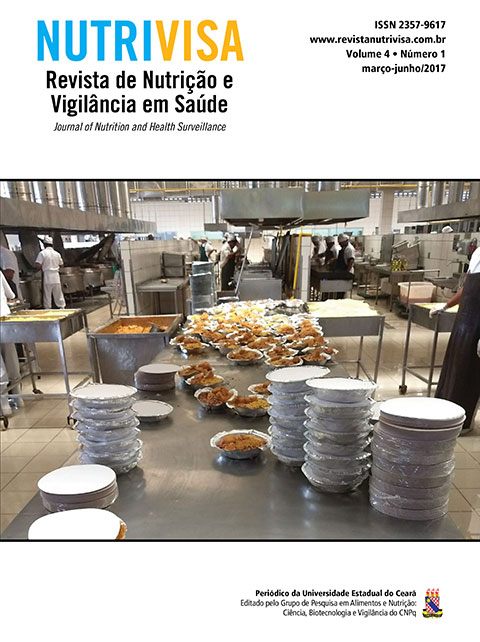Substitution of lunch and dinner for snacks among nutrition students
DOI:
https://doi.org/10.59171/nutrivisa-2017v4e9016Keywords:
meals, snacks, students, nutrition, nutritional statusAbstract
The present study aims to trace food and nutritional profile of the groups analysed in regards to replacing lunch and dinner for snacks, relating that with risk for developing chronic non- communicable diseases. This is a cross-sectional study, descriptive and quantitative, carried out in a university with female nutrition students of nutrition, both teenagers and adults. We assessed weight, height, waist circumference and applied a questionnaire about eating attitudes. We also applied the chi-square test (significance level of 5%) for verification of possible association of the replacement of meals with age group. In this study, 78 students participated, 30.8% (n = 24) were teenagers and 69.2% (n = 54) were adults. Both teenagers and adults replace more dinner (70.8% and 72.2% respectively) for snacks, and the frequency of replacing dinner was of 1-2 times a week (64.7% and 66.7% respectively). Foods cited in place of the dinner by teenagers were bread/cake/ cookie, pizza, couscous; the adults cited bread/cake/cookie, couscous, juice/pulp/fruit and coffee with milk. The substitute foods are low on nutritional value, presented high caloric value and the consumption of fruit and salads was insufficient overall.
References
BRASIL. Ministério da Saúde. Secretaria de Atenção á Saúde. Departamento de Atenção Básica. Política nacional de alimentação e nutrição. Brasília: Ministério da Saúde, 2011.
BRASIL. Ministério da Saúde. Portal Brasil: Substituir refeições por lanches pode provocar doenças – Brasil, 2014. Disponível em: <http://www.brasil.gov.br/ saude/2014/05/substituir-refeicoes-por-lanches-pode provocar-doencas>.
BRASIL. Ministério da Saúde. Boletim epidemiológico: HIV, AIDS. Ano I, n.01. Brasília: MS, 2012.
CUPPARI, L. Nutrição clínica no adulto. São Paulo: Manole, 2005.
CHERMONT PROCHNIK ESTIMA, C., et al. Meal consumption patterns and athropometric measurements in adolescents from a low socioeconomic neighborhood in the metropolitan area of Rio de Janeiro, Brazil. Appetite, 2009.
CARMO, M. B. et al. Consumo de doces, refrigerantes e bebidas com adição de açúcar entre adolescentes da rede pública de ensino de Piracicaba, São Paulo. Revista Brasileira de Epidemiologia, São Paulo, v. 9, n. 1, p.121-130, 2006.
GAUCHE, H. Comportamento Alimentar em Adultos de Florianópolis. Programa de Pós-Graduação em Saúde Pública. (Mestrado em Saúde Pública). Florianópolis (SC), 2008.
GASPARETTO, R. M.; SILVA, R. C. C. Perfil antropométrico dos Universitários dos cursos de nutrição, enfermagem, fisioterapia e educação física do centro universitário La Salle, Canoas/RS. Revista da Associação Brasileira de Nutrição, v. 4, n. 1, p. 29-33, 2014.
KORITAR, P.; ALVARENGA M.; PHILIPPI S, T; Consumo adequado de alimentos: qual o conceito das universidade brasileiras? Revista Brasileira de Nutrição Clínica. 2010.
LEAL, G.V. et al. Food Intake and meal patterns of adolescentes, São Paulo, Brazil. Ver Bras Epidemiol, 2010.
MENDONÇA, C. P.; ANJOS, L. A. Aspectos das práticas alimentares e da atividade física como determinantes do crescimento do sobrepeso-obesidade no Brasil. Cad. Saúde Pública, Rio de Janeiro, v. 20, n. 3, p. 698-709, mai./jun. 2004.
MONTEIRO, M. R. P. et al. Hábito e consumo alimentar de estudantes do sexo feminino dos cursos de Nutrição e de Enfermagem de uma universidade pública brasileira. Revista APS, v. 12, n. 3, p. 271-277, 2009.
RAMOS, S. A. Avaliação do estado nutricional de universitários. (Dissertação apresentada ao programa de pós graduação) – Faculdade de farmácia da UFMG, Belo Horizonte, 2005.
SCHIMIDT, M.I. et al. Chonicnoncommunicable diseases in Brasil: burden and currrent challenges. Lancet, London, v377, n. 287-99, 2011.
TEIXEIRA, A. S., et al., Substituição de refeições por lanches entre adolescentes. São Paulo: USP 2011.
TORAL, N. et al. Comportamento alimentar de adolescentes em relação ao consumo de frutas e verduras. Revista de Nutrição, Campinas, v. 19, n. 3, p. 331-340, 2006.
TAYLOR, R. W., et al. Evaluation of waist circumference, waist-to-hip ratio, and theconicity index as screening tools for high trunk fat mass, as measured by dual- energy X-ray absorptiometry, in children aged 3-19 y. The American Journal of Clinical Nutrition, 72: 490- 495, 2000.
WORLD HEALTH ORGANIZATION. Division of Noncommunicable Diseases/World Health. Organization/Programme of Nutrition Family and Reproductive Health.Obesity - preventing and managing the global epidemic: report of a WHO Consultation on obesity. WHO/NUT/NCD/98.1. World Health Organization: Geneva, 1998.
WORLD HEALTH ORGANIZATION. The World Health Report 2002: reducing risks, promoting healthy life. Geneva: WHO;2002.
WORLD HEALTH ORGANIZATION. Physical status: the use and interpretation of athropometry. Geneva: WHO Technical Report Series, 1997.
WORLD HEALTH ORGANIZATION. Growth reference data for 5-19 years: Application tools Related publications Height-for-age (5-19 years) and BMI-for- age (5-19 years). WHO, 2007. Disponível em: .
Published
How to Cite
Issue
Section
License
Copyright (c) 2017 LygiA VAnEssA EvAngELIsTA Guimarães, Maria Francisca Almeida Silva, Ana Caroline de Castro Ferreira Fernandes

This work is licensed under a Creative Commons Attribution 4.0 International License.














